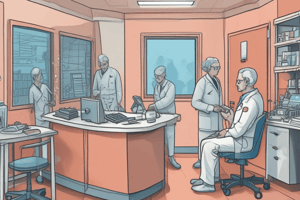Podcast
Questions and Answers
What are the key components of the communication cycle in healthcare?
What are the key components of the communication cycle in healthcare?
- Sender, receiver, message (correct)
- Active listening, empathy, dialogue
- Patient, medical assistant, physician
- Feedback, understanding, compassion
Active listening is a crucial part of therapeutic communication.
Active listening is a crucial part of therapeutic communication.
True (A)
What does HIPAA stand for and why is it important in healthcare communication?
What does HIPAA stand for and why is it important in healthcare communication?
HIPAA stands for Health Insurance Portability and Accountability Act. It is important in healthcare communication to ensure patient confidentiality and privacy.
In therapeutic communication, ________ aims to build a positive rapport and relationship between the healthcare provider and the patient.
In therapeutic communication, ________ aims to build a positive rapport and relationship between the healthcare provider and the patient.
Match the following communication styles with their descriptions:
Match the following communication styles with their descriptions:
Which of the following is a key aspect of active listening?
Which of the following is a key aspect of active listening?
Maintaining composure despite a patient's emotional state involves demonstrating understanding and using 'You' statements.
Maintaining composure despite a patient's emotional state involves demonstrating understanding and using 'You' statements.
What should medical assistants avoid using to prevent confusion when communicating with patients?
What should medical assistants avoid using to prevent confusion when communicating with patients?
______ is the process of providing a safe environment for all vested members in a healthcare organization.
______ is the process of providing a safe environment for all vested members in a healthcare organization.
What kind of communication style is recommended when interacting with medical professionals?
What kind of communication style is recommended when interacting with medical professionals?
Cultural differences do not influence how people believe medical conditions should be treated.
Cultural differences do not influence how people believe medical conditions should be treated.
During telephone communication, it is essential to remain _______ while speaking to patients.
During telephone communication, it is essential to remain _______ while speaking to patients.
Match the following types of letter formats with their descriptions:
Match the following types of letter formats with their descriptions:
Flashcards
Effective Communication
Effective Communication
Exchange of information promoting trust and understanding.
Communication Cycle
Communication Cycle
Sender, receiver, and message components involved in conveying information
Therapeutic Communication
Therapeutic Communication
Empathetic communication that promotes patient comfort and well-being.
Active Listening
Active Listening
Signup and view all the flashcards
Assertive Communication
Assertive Communication
Signup and view all the flashcards
Acting as a Liaison
Acting as a Liaison
Signup and view all the flashcards
Scope and Boundaries
Scope and Boundaries
Signup and view all the flashcards
Coaching and Feedback
Coaching and Feedback
Signup and view all the flashcards
Nonverbal Communication
Nonverbal Communication
Signup and view all the flashcards
Diversity Considerations
Diversity Considerations
Signup and view all the flashcards
Psychosocial Care
Psychosocial Care
Signup and view all the flashcards
Telephone Communication
Telephone Communication
Signup and view all the flashcards
Crucial Conversations
Crucial Conversations
Signup and view all the flashcards
Study Notes
Effective Communication in Healthcare
- Effective communication is critical for medical assistants (MAs) to interact with patients and collaborate with healthcare professionals.
- Clear and empathetic communication promotes trust and rapport with patients, making them feel heard, respected, and understood.
- Strong communication skills allow MAs to effectively relay patient information to physicians, nurses, and other team members, fostering a collaborative environment that improves patient outcomes.
The Communication Cycle
- The communication cycle consists of three key components: a sender, a receiver, and a message.
- The sender initiates communication by conveying information, thoughts, or feelings.
- The receiver interprets and understands the message, and feedback from the receiver can lead to changes or clarifications from the sender.
Therapeutic Communication
- Therapeutic communication is a specialized type of communication used in healthcare that requires strong empathetic communication abilities.
- It aims to build a positive rapport and relationship between the healthcare provider and the patient, promoting patient comfort and well-being.
- Active listening, empathy, and clear, compassionate dialogue are essential skills in therapeutic communication.
Active Listening Techniques
- Active listening involves paying close attention to what is being said, comprehending nuances and emotions, and responding carefully.
- It promotes open and clear communication, resulting in a deeper understanding between the sender and receiver.
- Techniques include maintaining non-judgmental and positive body language, allowing the speaker to convey their message without interruption, and thoughtfully considering the message before responding.
Considerations and Tone
- When communicating with patients, consider confidentiality, privacy, and cultural sensitivity.
- Avoid using medical jargon and instead use clear and concise language.
- Be aware of and respectful of the patient's cultural background, language preferences, and potential communication barriers.
Communication Styles
- Assertive communication is the ideal style for healthcare, characterized by a firm and direct approach.
- Passive, aggressive, and manipulative styles can be ineffective and even damaging.
- Recognizing communication styles enables tailoring responses to be more effective for the person being communicated with.
Acting as a Liaison
- MAs can help patients and providers communicate more effectively by paraphrasing and clarifying information.
- Active listening promotes accurate and effective communication with the provider, which is then relayed to the patient.
Interview and Questioning Techniques
- Ask clear and professional questions, using open-ended questions to elicit more information from patients.
- Use screening questions to determine medical needs and the reason for an office visit.
Scope and Boundaries
- When gathering information from patients, maintain professional boundaries and seek information about their health only.
- Refrain from sharing personal information, experiences, or other patient experiences.
- Respect patient privacy and confidentiality.
Coaching & Feedback
- Consider the patient and factors that influence communication, such as age, comprehension level, and cultural background.
- Practice empathy and encourage positive behaviors and choices that benefit patient health.
- Provide opportunities for patients to provide feedback and ask questions.
Providing a Customer Service Approach
- Customize communication to meet the needs of the intended recipient.
- Use active listening skills to ensure effective communication.
- Consider the patient's age, cultural background, and potential communication barriers.
Nonverbal Communication
- Nonverbal communication can be equally important as spoken language.
- Use body language, facial expressions, and gestures to support a message, not contradict it.
- Be aware of personal space and avoid crowding or invading the patient's space.
- Use therapeutic touch to calm patients and demonstrate care, but ensure patient consent.
Communication for a Diverse Audience
- Adjust communication approaches for patients, families, and medical professionals.
- Use lay terms when communicating with patients and families.
- Maintain a positive working relationship with medical professionals.
- Eliminate stereotypes and biases to ensure clear communication.
Patient and Family Communication
- Communicate with patients and families in a way that improves the quality of patient care.
- Respect patient privacy and confidentiality when communicating with families.
- Ensure patient consent before sharing information with families.
Medical Professionals Communication
- Communicate with medical professionals in a professional and respectful manner.
- Maintain a positive working relationship and open communication to reduce miscommunications.
Stereotypes & Biases
- Identify and eliminate stereotypes and biases to ensure clear communication.
- Respect diversity, including language, culture, socioeconomic status, and age.
- Show respect and professionalism in all interactions.
Gender Identity and Expression
- Ask patients for their preferred name, title, and pronouns.
- Don't assume someone's marital status or gender identity.
- Open communication helps establish rapport and relationships, creating a safe and comfortable environment.
Patient Characteristics and Communication
- Identify and address potential barriers, such as language, culture, and comprehension level.
- Adjust communication approaches accordingly, asking patients how they want to be assisted.
- Provide accommodations, such as interpreters or assistive devices, as needed.
Patient Cultures and Backgrounds
- Be mindful of cultural differences and traditions.
- Avoid making assumptions and stereotyping.
- Learn about and understand different cultures to provide effective cultural, religious, psychosocial, and economic sensitivity.
Cultural, Religious, Psychosocial, and Economic Considerations
- Provide psychosocial care, defined as psychological, social, and spiritual care delivered through therapeutic communication with cultural sensitivity.
- Be aware of cultural differences in how people believe conditions should be treated.
- Adjust language and communication approaches as needed to ensure that the medical team can meet the patient's requirements.
Types of Visit Considerations
- Consider the type of visit, whether in-person or virtual, and adjust communication approaches accordingly.
- Ensure clear audio and visual components, and use features such as closed captions to assist patients with hearing or visual impairments.
- Use nonverbal cues, such as facial expressions and eye contact, to improve the effectiveness of the interaction.### Effective Communication in Healthcare
Telephone Communication
- Maintain privacy, security, and confidentiality when communicating with patients, caregivers, or third-party payers
- Use clear enunciation, a friendly tone, and active listening to ensure effective communication
- Avoid using medical jargon and be succinct when speaking
- Smiling while speaking on the phone can improve the tone of the conversation
- Five Ps of Phone Etiquette:
- Polite: Use a gentle, friendly tone
- Prepared: Have necessary information ready
- Pointed: Be succinct and straightforward
- Perceptive: Respect the caller's time by remaining on topic
- Cooperative: Provide necessary information or refer to someone who can assist
Written and Electronic Communication
- Written communication is part of the patient's permanent legal record and must follow professional standards and HIPAA guidelines
- Use secure email software, proofread for spelling and grammar errors, and avoid slang or jargon
- Emails should be professional, concise, and have a subject line, salutation, closing, and contact information
- Business letters are formal documents used for various purposes, such as addressing concerns or informing patients
- Letters should be error-free, grammatically correct, and properly formatted
Crucial Conversations
- Crucial conversations involve difficult topics or emotionally charged situations
- Strategies for handling crucial conversations:
- Patience and empathy
- Active listening
- Emotional regulation
- Clear and compassionate communication
- Collaboration with caregivers
- Utilizing de-escalation techniques
Communication with Healthcare Team
- Communication with healthcare team requires professionalism and respect
- Strategies for effective communication:
- Show respect for knowledge and authority
- Open and honest communication
- Professionalism in conflict
- Documenting incidents, events, and unusual occurrences
Challenging Customer Service Situations
- When dealing with upset or frustrated patients:
- Maintain professionalism and respect
- Avoid negative energy
- Build relationships
- De-escalate problem situations
- Act quickly, involve supervisors, and set boundaries
Conflict Management and Complaint Resolution
- Effective conflict management includes:
- Allowing expression
- Active listening
- Seeking solutions
- Respectful communication
- Cause and effect analysis influences patient satisfaction and safety
Teamwork and Professionalism in Healthcare
- Facilitate teamwork and engagement by:
- Clear definition of roles
- Collaboration
- Interdisciplinary approach
- Positive work environment
- Conflict resolution
- Supportive culture
- Professional conduct
- Strategies for increasing engagement and satisfaction:
- Implementing engagement strategies
- Professional development opportunities
- Regular feedback
- Demonstrate professionalism through:
- Respect
- Boundaries
- Professional presence
- Time management
- Relationships
Studying That Suits You
Use AI to generate personalized quizzes and flashcards to suit your learning preferences.




